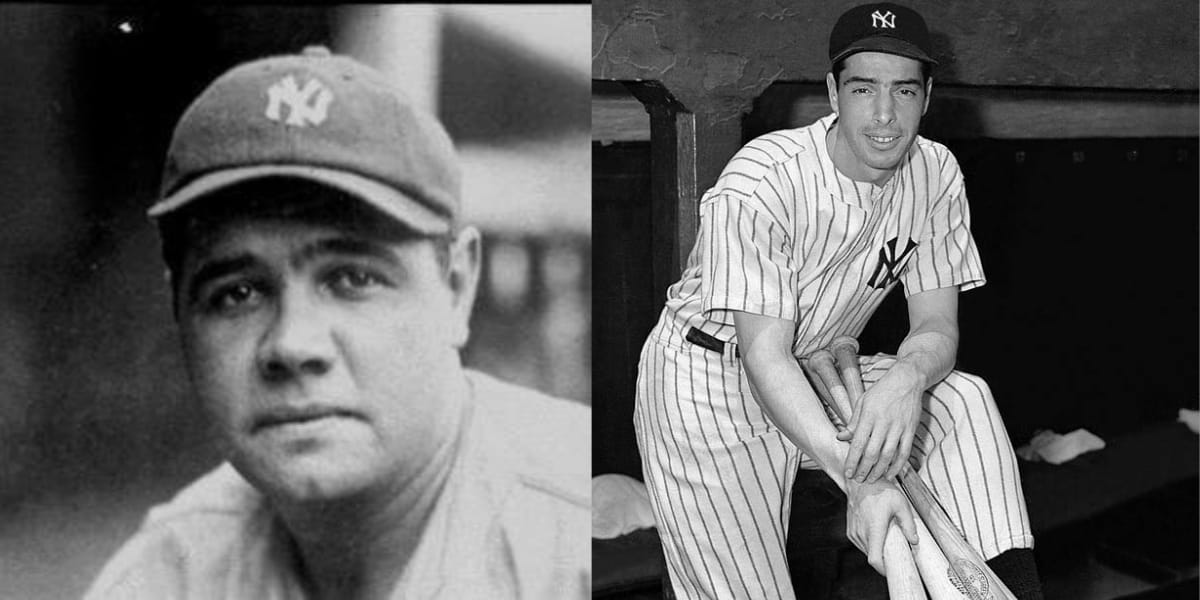- Baseball Daily Rewind
- Posts
- ⚾ Joe DiMaggio declared Baseball’s “Greatest Living Player”
⚾ Joe DiMaggio declared Baseball’s “Greatest Living Player”
1969 Marked the 100th year of baseball - Looking back on the polls now and then
Receive Honest News Today
Join over 4 million Americans who start their day with 1440 – your daily digest for unbiased, fact-centric news. From politics to sports, we cover it all by analyzing over 100 sources. Our concise, 5-minute read lands in your inbox each morning at no cost. Experience news without the noise; let 1440 help you make up your own mind. Sign up now and invite your friends and family to be part of the informed.

July 21, 1969, Major League Baseball celebrates the national pastime’s centennial anniversary with a gala banquet at the All-Star Game. The festivities include the announcement of an all-time team. Hall of Famer Babe Ruth is voted the "Greatest All-Time Player." Another Hall of Famer, Joe DiMaggio, is selected the "Greatest Living Player."
Marty Appel took revisited this event 44 years later and here are his thoughts:
Bowie Kuhn, the new acting commissioner was ready to wake up the sleepy game of baseball in its first year of division play, and was talking to Gillette about underwriting fan voting for the All-Star starting lineups the following year.
But first, there was the centennial to mark, with a Nixon White House celebration, an All-Star Game in Washington, a poster, a US postage stamp, and a record album narrated in part by Jimmy Stewart.
A special logo to be worn on all uniform sleeves and that patriotic looking logo remains the MLB logo today – the batter who looks a lot like Harmon Killebrew, but isn’t. (That, according to the designer, Jerry Dior).
And the cornerstone was to be the selection of baseball’s all-time teams – one covering all of baseball history…greatest players ever, and one for “living players.” Individually, each team was to have its own poll for its own all-timers and “greatest moment ever.”
The greatest all-time team included Lou Gehrig at first, Rogers Hornsby at second, Honus Wagner at short, Pie Traynor at third, Babe Ruth, Ty Cobb and DiMaggio in the outfield, Mickey Cochrane catching, Walter Johnson as the right handed pitcher, and Lefty Grove as the left handed pitcher. John McGraw was the manager.
The great living players were George Sisler and Stan Musial (tied) at first, Charlie Gehringer at second, Joe Cronin at short, Traynor at third, DiMaggio, Ted Williams and Willie Mays in the outfield, Bill Dickey catching, Bob Feller right hand pitcher, Grove left hand pitcher, and Casey Stengel, manager. Mays was the only player still active.
One thing that jumps out is how Pie Traynor’s stock seems to have fallen. The number one third baseman on both lists would be recognized by very few young fans today, and might have trouble making the top ten if such a vote was cast today.
It is also interesting to see DiMaggio on the all-time team having surpassed Tris Speaker, whom most old timers held sacred, both for his defense and offense, as the middle outfielder between Ruth and Cobb. Speaker’s time was now over.
On the living team, this would surely have been the moment that Mays over Mantle stirred hard feelings in New York. But even Mickey would come to acknowledge that in the end, Mays had the better career. Mantle, just four months after his retirement announcement, was at the peak of his popularity, but the memory of four rather ordinary final seasons was very much on people’s minds.
The selection of Cochrane at catcher could be seen as putting an end to the debate over Cochrane, Gabby Hartnett, Roy Campanella, Yogi Berra and Bill Dickey. Today, Johnny Bench and Mike Piazza would be part of the discussion. Cochrane’s supremacy prior to Bench’s big years is noteworthy. Also, Dickey winning over Berra would probably not be the case today if both were living.
Little thought seems to have been given to the Negro Leagues, where Satchel Paige and Josh Gibson stood above all others. The Hall of Fame did not embrace the Negro Leagues until two years later.
I recall some chatter at the time about a few of the living selections being “cooked.” Cronin, a lifetime .301 hitter, may well have deserved the nod as greatest living shortstop, (over Luke Appling, Pee Wee Reese, Phil Rizzuto and Lou Boudreau), but one suspects that the baseball powers pre-ordained that he would emerge on top – given that he was the reigning American League President and a key figure at the White House event.
Likewise, one wonders now if Sisler won at first base but Musial, who was the head of the President’s Council on Fitness and Sports, was slipped in to create a tie.
Grove, the greatest living left-hander over Sandy Koufax? So it was decided, and with merit. (Bowie Kuhn liked to talk about Grove during the White House visit, pulling over some 19th century chair and plopping his feet on it as he relaxed).
There will come another anniversary – there are always anniversaries – and a chance to have another vote. But the takeaways from the 1969 vote were that 1) It was, in a sense, the debut of modern marketing for Major League Baseball, not yet known as “MLB”, 2) the event gave DiMaggio 30 years of introductory commentary, which he greatly enjoyed, and 3) so seemingly important at the time, but not even worthy of the 1970 Baseball Guide. Here is the full article.
Todays featured Podcast:
Did you know?
July 21, 1970, San Diego Padres manager Preston Gomez lifts starter Clay Kirby for a pinch-hitter in the eighth inning, even though the right-hander has a no-hitter in progress. With the Padres trailing 1-0, Gomez decides to play for the win instead of letting Kirby finish. The Padres eventually lose both the game and the no-hitter. Gomez would repeat the mistake in 1974 as well.
TRIVIA
Who won the Manager of the Year Award just a few weeks after he had been fired as a manager?
Hint: #1 In his only All-Star game as a player, he was the only player on either team, starter or reserve, who didn’t see any action on the field.
Hint: #2 He was the catcher for both Dwight Gooden’s no-hitter and David Cone’s perfect game.
July 21, 1919 18,000 fans packed Comiskey Park to watch the White Sox sweep the Yankees in a thrilling doubleheader—two walk-off wins, both saved by pitcher Dickie Kerr in relief.
But joy turned to horror during Game 2 when fans looked up and saw the Wingfoot Express blimp burst into flames and crash into the Illinois Trust and Savings Bank. 14 people died, including a mechanic named Carl “Buck” Weaver, sharing a name with Sox third baseman Buck Weaver—who had just won Game 1.
The tragedy, witnessed by thousands, ended the day in stunned silence—and led to major changes in air safety, including banning hydrogen in U.S. airships.
July 21, 1947, Mickey Cochrane, Frankie Frisch, Lefty Grove, and Carl Hubbell are inducted into the Hall of Fame. Cochrane and Grove had made their major league debuts in the same game for the Philadelphia Athletics in 1926. Frisch and Hubbell were stars in the National League, Frisch having served as player/manager for the Gashouse Gang Cardinals, he becomes the first switch-hitter inducted into the Hall of Fame. "King Carl" hurled for the Giants and on July 21, 1952, two new members are inducted into the Hall of Fame: outfielders and batting champions Harry Heilmann and Paul Waner.
July 21, 1959, the Boston Red Sox become the last team to debut a black player when Elijah “Pumpsie” Green appears in a game as a pinch-runner and shortstop. Green’s debut with Boston comes 12 years after Jackie Robinson’s historic debut with the Brooklyn Dodgers.
July 21, 1962 -- Craig Anderson throws a seven-hit, complete-game against Cincinnati, but New York cannot overcome Marv Throneberry's error which would have ended the fifth inning, giving Vada Pinson the opportunity to hit a two-out, two-run homer. The eventual 5-3 defeat at Crosley Field makes the right-hander the third consecutive Mets' starter, following losing efforts by Jay Hook and Roger Craig, to pitch a complete game and not get a victory.
Listen to this Mets Semi Classic:
YOU CAN EARN FREE ⚾ GIFTS
Here’s what you get when you refer friends:
⚾ Refer 5 friends — get a Happy Birthday shoutout in the newsletter!
⚾ Refer 10 friends — get 1 free month of Classic Baseball Broadcasts
⚾ Refer 25 friends — get 1 full year of access to those amazing old-time radio games
You currently have 0 referrals, only 5 away from receiving Get a birthday shout out! .
Just share this link with any baseball fans in your life to your friends, or any social media site, blog post or facebook groups!
July 21, 1975 -- New York Mets' infielder Joe Torre becomes the first player in National League history to hit into four straight double plays in one game. Felix Millan singles in four consecutive at-bats against the Astros, making the dubious mark possible.
Said Torre after the game to reporters, “ It’s the first record I’ve ever set in baseball. But I’m not nearly as embarrassed by it as I am by my RBI total. I couldn’t have set a record without Millan. He ought to get an assist.” Showing a sense of humor, Torre added, “When I retire, I’m going to buy a shortstop and put him in my den. At night, when I’m lonely, I’m going to go down there and hit grounders to him.”
The Mets drop a 6-2 verdict to the Astros. Ken Forsch gets the win and said all of Torre's double plays were on sliders. Roger Metzger has a two-run triple and starts three of Torre's recurring nightmares.
July 21, 1988, the New York Yankees make the infamous “Ken Phelps Trade” with the Seattle Mariners. The Yankees acquire the veteran first baseman/DH for promising outfield prospect Jay Buhner. Phelps will remain with the Yankees for parts of only two seasons, while Buhner will emerge as a star, reaching the 40-home run mark in 1995, ’96, and ’97. Even Seinfeld questioned this trade and for good measure . . . On July 21, 1993 -- Seattle Mariner OF Jay Buhner collects five hits in Seattle's 10 - 3 win over the Yankees, who had traded him to Seattle exactly five years prior. Erik Hanson goes all the way, allowing no earned runs to beat Jimmy Key.
July 21, 1988 -- Red Sox veteran Jim Rice is suspended for three games by the club for shoving manager Joe Morgan. Rice was angered when Morgan replaced him with the light-hitting shortstop Spike Owen in the 8th inning of Boston's eventual 9 - 7 win over Minnesota.
July 21, 2004 At Fenway Park - Thanks to an unusual play in the outfield, David Newhan hits a rare inside-the-park homer at Fenway. Inexplicably, Red Sox outfielder Manny Ramirez, from left field, cuts off the relay throw from center fielder Johnny Damon, allowing two Orioles to score in Baltimore's 10-5 victory.
Quote of the day:
"He was a shy, meticulous man. He cooked for himself. He pumped his own gas, shined his own shoes." - attorney Morris Engelberg about DiMaggio in later life


